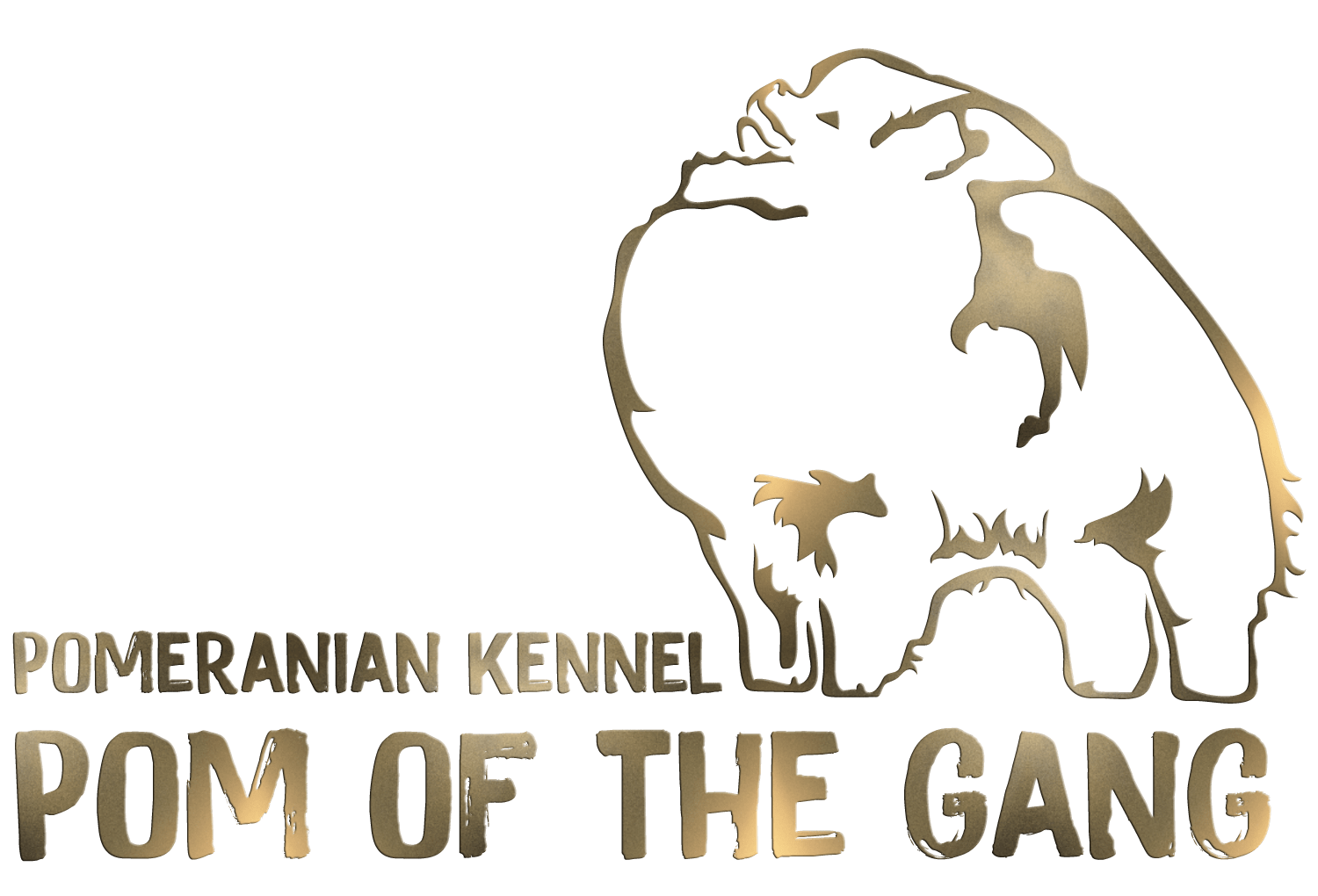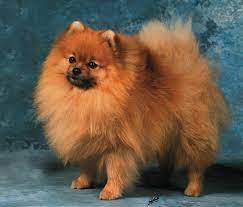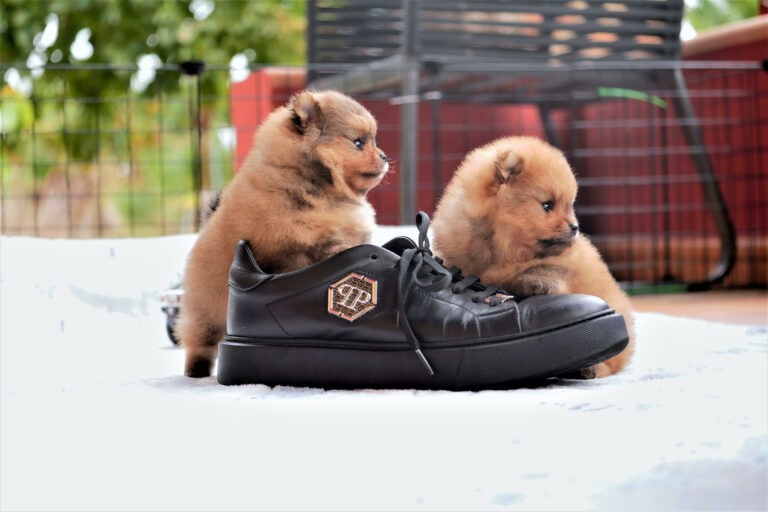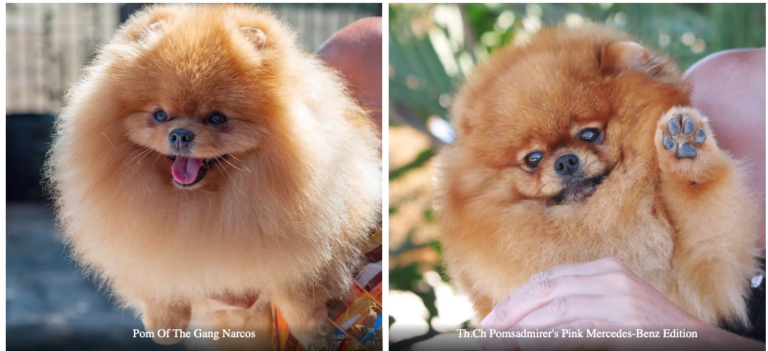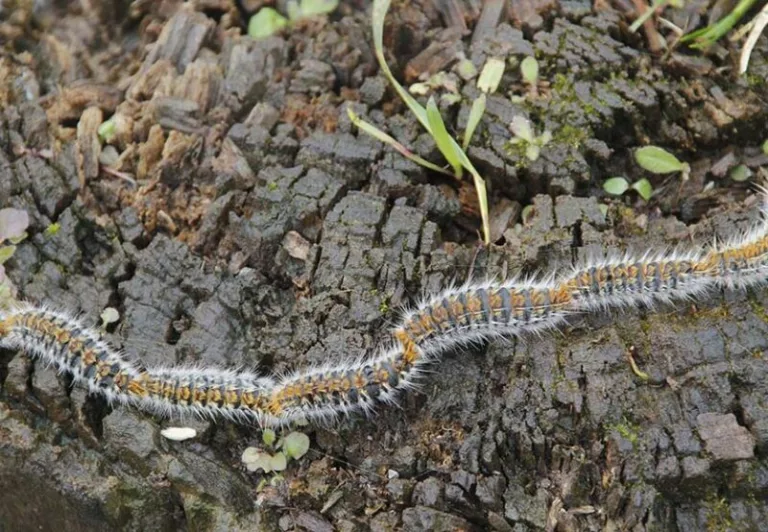BRIEF HISTORICAL OVERVIEW:
German Spitz, descended from the Stone Age bog dog "Canis familiaris palustris Rütimeyer" and later "lake city dogs", are the oldest breed in Central Europe and many other breeds are descended from them. In non-German speaking countries, Miniature Spitz are also called Pomeranian Spitz.
GENERAL APPEARANCE: Spitz seduce with the beauty of their fur puffed up by an abundant undercoat. The neck with an opulent mane-shaped ruff and the bushy tail carried proudly on the back are particularly striking. Its head with bright eyes reminiscent of a fox and its small, pointed ears close together give the Spitz its characteristic sassy appearance.
IMPORTANT PROPORTIONS : The ratio between the height at the withers and the length of the dog's body is 1:1. The ratio between the length of the muzzle and the length of the skull is. 2:4.
BEHAVIOR / TEMPERAMENT: The Miniature Spitz/Pomeranian is always attentive, lively and extraordinarily attached to its master. He is very receptive and easy to train. His pleasant and cheerful character makes him an ideal companion and family dog and a guardian for the house and apartment. He is neither fearful nor aggressive. Weather resistance, robustness and longevity are other qualities that set it apart.
HEAD
CRANIAL REGION: Of medium size, the head of the Spitz, seen from above, is widest in its posterior part and tapers into a wedge shape to the tip of the nose.
Stop : Moderately to well marked, never abrupt.
FACIAL REGION:
Nose : Small and round, it is pure black in color; nevertheless brown in all brown Spitz.
Muzzle : It is not too long, neither coarse nor pointed and well proportioned to the skull (proportion approx. 2:4).
Lips : Lips do not overlap. They are well stretched and do not crease at the corners. Their pigmentation is black, however brown in all brown Spitz.
Jaws/teeth : Normally developed, the jaws have a complete scissor bite formed by 42 teeth according to the dog's dental formula. The upper incisors cover the lower incisors in close contact, the teeth being set square to the jaws. Powerful, the fangs fit together perfectly (canines). In Miniature Spitz/Pomeranians, the moderate absence of premolars is accepted. A pincer joint is tolerated.
Cheeks : The cheeks are delicately rounded without being protruding.
EYES: Medium size, slightly almond-shaped and in a slightly oblique position, the eyes are dark in color, dark brown in all brown Spitz.
EARS : The Spitz's small ears are set high, relatively close to each other, triangular and pointed; they are always carried erect with a very rigid point.
NECK : Of medium length, the neck, wide at the insertion between the shoulders, has a slightly curved nape. Without a dewlap, it is covered with a mane-shaped collar.
BODY :
Topline : It continues after a gentle curvature in the short, horizontal back. The bushy tail folded over the back, part of which it covers, completes the silhouette.
Withers : The top of the withers decreases imperceptibly.
Back : As short as possible, straight, firm.
Loin : Short, broad and powerful.
Rump : The rump is broad, short and not swallowed.
Chest : The chest is deep and well rounded; the sternal region is well developed.
Underline and belly : The ribcage is developed as far back as possible; the stomach is only moderately raised.
TAIL :
Set high and of medium length, the tail, very bushy, is erect from its root, folded forward and rolled over the back, on which it rests firmly. A double loop at the end of the tail is accepted.
FOREQUARTERS:
Overview : They are straight and the front is rather broad with a powerful bone.
Shoulder : The shoulder is well muscled and firmly attached to the rib cage. The shoulder blade is long and oblique towards the rear.
Arm : Approximately the same length as the shoulder blade, it forms an angle of approximately 90° with the latter.
Elbow : The elbow joint is solid, well against the thorax and turned neither in nor out.
Forearm : Of medium length, vigorous in comparison to the trunk, perfectly straight, its posterior face is well furnished with fringes.
Metacarpus : The metacarpus, strong and of medium length, forms an angle of approximately 20° with the forearm relative to the vertical.
Forefeet : The forefeet are as small as possible, round, with tight, well-arched toes called cat's feet. The color of the nails and pads is as dark as possible.
HINDQUARTERS:
Overview : The hind limbs are very muscular and bear abundant breeches up to the hock. The hindquarters are straight and parallel.
Thigh and leg : The thigh and leg are approximately the same length.
Stifle (knee) : The stifle joint is only moderately angulated; it is solid and, during movement, does not shift inwards or outwards.
Tarsus/Hock : Of medium length, the metatarsus, very robust, is perpendicular to the ground.
Hind Feet : The hind feet are as small as possible, round, with tightly packed, arched toes called cat's feet; the pads are durable. The color of the nails and pads is as dark as possible.
GAIT:
Thanks to a good impulse, the movement of the Miniature German Spitz/Pomeranian is smooth and elastic.
SKIN :
The skin adheres well to the body and does not form any folds.
DRESS :
Coat quality : Miniature German Spitz/Pomeranians have a double coat: a long, straight, spread top coat and a firm, short, thick, wadded undercoat. The head, ears, front surfaces of the fore and hind limbs and feet have short, dense (velvety) hair; the rest of the body has long and abundant hair. Neither wavy, nor curly, nor shaggy, it does not form a part on the back. The neck and shoulders are covered with an abundant mane. The posterior surfaces of the forelimbs are well furnished with fringes, the hind limbs have opulent breeches from the rump to the hock and the tail is bushy. The shaping of the hair is not visible.
Coat color : German Miniature Spitz/Pomeranian : White, black, brown, orange, shaded gray, other color.
White Spitz : The coat must be pure white, the yellowish shades often visible on the ears are tolerated.
Black Spitz : For the coat of the Black Spitz, the undercoat and skin must also be dark in color. On the surface, the color is a lacquered black without streaks or spots of white or any other color.
Brown Spitz : The coat of the Brown Spitz must be dark brown, evenly distributed and uniform.
Orange Spitz : The coat of the Orange Spitz should be evenly distributed and uniform in a medium shade. White shades (and not spots!!!) on the chest, feet and tip of the tail are tolerated.
Wolf-gray (shaded-gray) Spitz : Wolf-gray is a silvery-charcoal gray (with black at the tips of the hair). The muzzle and ears are dark. Around the eyes there is a clearly marked "spectacle arm" design, formed by a delicately drawn black line running diagonally from the outer angle of the eye to the lower attachment point of the ear, associated with clean hatching and shaded gradients forming short, expressive eyebrows. The mane and shoulder area is lighter. The fore and hind limbs are silvery gray without black spots below the elbows and knees, except for light streaks on the toes. The tip of the tail is black. The underside of the tail and the breeches are a light silvery gray.
Spitz of other colors : Under this name “other colors” include coats of all other shades: cream, cream-sable, orange-sable, black and tan, variegated. Variegated (or parti-colored) dogs must have a white background and black, brown, gray or orange spots must be distributed throughout the body.
HEIGHT AND WEIGHT :
Height at withers :
Miniature Spitz/German Pomeranian : 21 cm ± 3 cm
Each size variety of the Miniature German Spitz/Pomeranian must have a weight corresponding to its size.
DEFAULTS :
Any deviation from the above must be considered a defect which will be penalized according to its seriousness and its consequences on the health and well-being of the dog.
SERIOUS DEFECTS:
• Construction defects.
• Head too flat.
• Head shaped like an apple.
• Flesh-colored nose, eyelids and lips (ladre).
• Defect in teeth, absence of teeth.
• Eyes too big or too light.
• Prominent eyes.
• Absence of the characteristic facial pattern in wolf-grey Spitz.
• Defective gaits.
DEFECTS LEADING TO EXCLUSION :
• Aggressive dog or fearful dog.
• Any dog with obvious physical or behavioral abnormalities.
• Persistence of the fontanelle.
• Upper or lower prognathism, crossbite.
• Entropion or ectropion.
• Ears partially erect
• Small spots or clearly visible white marks (example: “Socks”)
• Color variants that are not listed.
NB :
• Males should have two normal-appearing testicles fully descended into the scrotum.
• Only healthy dogs capable of performing the functions for which they were selected, and whose morphology is typical of the breed, may be used for breeding.
Source; FCI: https://www.fci.be/Nomenclature/Standards/097g05-fr.pdf
